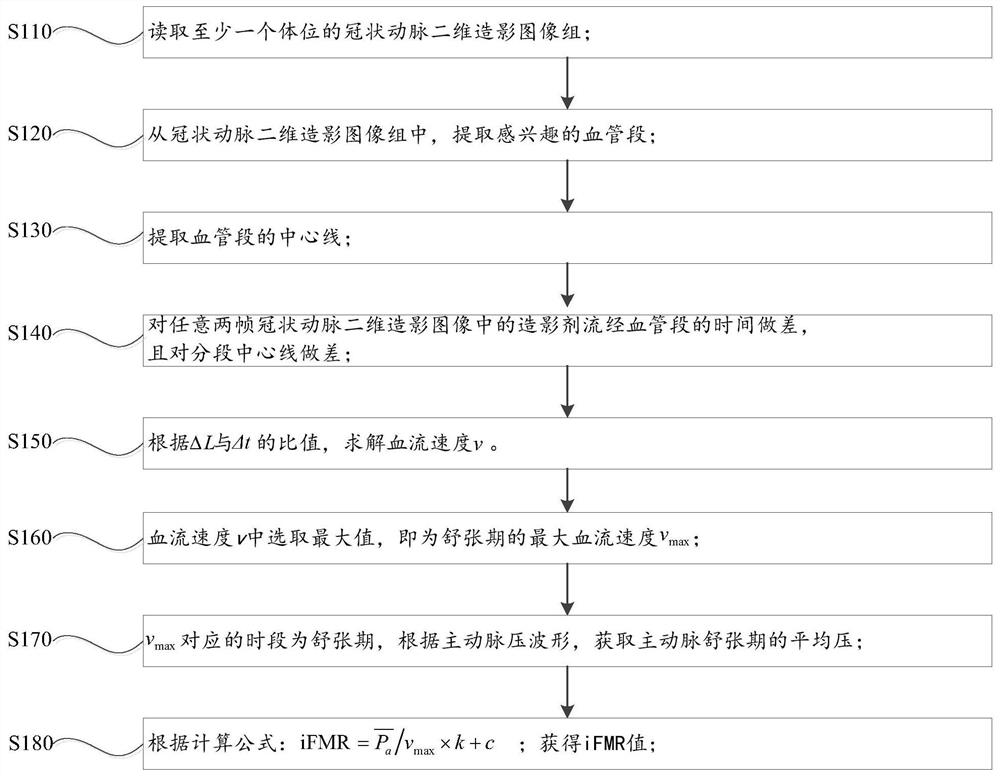Method and device for adjusting maximum hyperemia state flow rate based on microcirculation resistance index
A technology of blood flow velocity and index, applied in blood flow measurement, image data processing, image enhancement, etc., to achieve the effect of individualized differences
- Summary
- Abstract
- Description
- Claims
- Application Information
AI Technical Summary
Problems solved by technology
Method used
Image
Examples
Embodiment 1
[0098] Embodiment 1: In order to solve the above problems, as figure 1 As shown, the present application provides a method for adjusting the blood flow velocity under the maximum congestion state based on the microcirculation resistance index, including:
[0099] S100, according to the blood flow velocity v, aortic pressure waveform, and influencing parameters, obtain the microcirculation resistance index iFMR in diastole;
[0100] S200, if the diastolic microcirculation resistance index iFMR Among them, K is a positive number less than 100;
[0101] S300, according to the formula v'=rv h , to obtain the corrected maximum blood flow velocity in the state of hyperemia;
[0102] Among them, v' represents the corrected maximum blood flow velocity in the state of hyperemia, v h Indicates the blood flow velocity in the state of maximum hyperemia.
[0103] In one embodiment of the present application,
[0104] v h Indicates the blood flow velocity in the state of maximum hyp...
Embodiment 2
[0107] The present application provides a method for adjusting the blood flow velocity in the state of maximum hyperemia based on the microcirculation resistance index, including:
[0108] S100, according to the blood flow velocity v, aortic pressure waveform, and influencing parameters, obtain the diastolic microcirculation resistance index iFMR; wherein
[0109] 1) if figure 2 As shown, when the blood flow velocity is obtained through a two-dimensional contrast image, the methods for obtaining the blood flow velocity v include:
[0110] S110, reading a group of coronary angiography two-dimensional angiography images of at least one body position;
[0111] S120, extracting the vessel segment of interest from the group of coronary angiography two-dimensional angiography images, the specific method is as follows image 3 shown, including:
[0112] S121, selecting N frames of coronary two-dimensional angiography images from the coronary two-dimensional angiography image grou...
Embodiment 3
[0139] In one embodiment of the present application, the method for obtaining the blood flow velocity v through three-dimensional modeling in S100 includes:
[0140] Step A, reading at least two groups of coronary angiography images in two body positions;
[0141] Step B, extracting the vessel segment of interest from the two-dimensional coronary angiography image group;
[0142] Step C, obtaining the geometric structure information of the blood vessel segment, and extracting the center line of the blood vessel segment;
[0143] Step D, performing graphic processing on the vessel segment of interest;
[0144] Step E, extracting the vessel contour of the vessel segment;
[0145]Step F, according to the geometric structure information of the blood vessel segment, project the two-dimensional coronary angiography images of at least two body positions with the centerline and contour line of the blood vessel extracted on a three-dimensional plane to synthesize a three-dimensional ...
PUM
 Login to View More
Login to View More Abstract
Description
Claims
Application Information
 Login to View More
Login to View More - R&D
- Intellectual Property
- Life Sciences
- Materials
- Tech Scout
- Unparalleled Data Quality
- Higher Quality Content
- 60% Fewer Hallucinations
Browse by: Latest US Patents, China's latest patents, Technical Efficacy Thesaurus, Application Domain, Technology Topic, Popular Technical Reports.
© 2025 PatSnap. All rights reserved.Legal|Privacy policy|Modern Slavery Act Transparency Statement|Sitemap|About US| Contact US: help@patsnap.com



